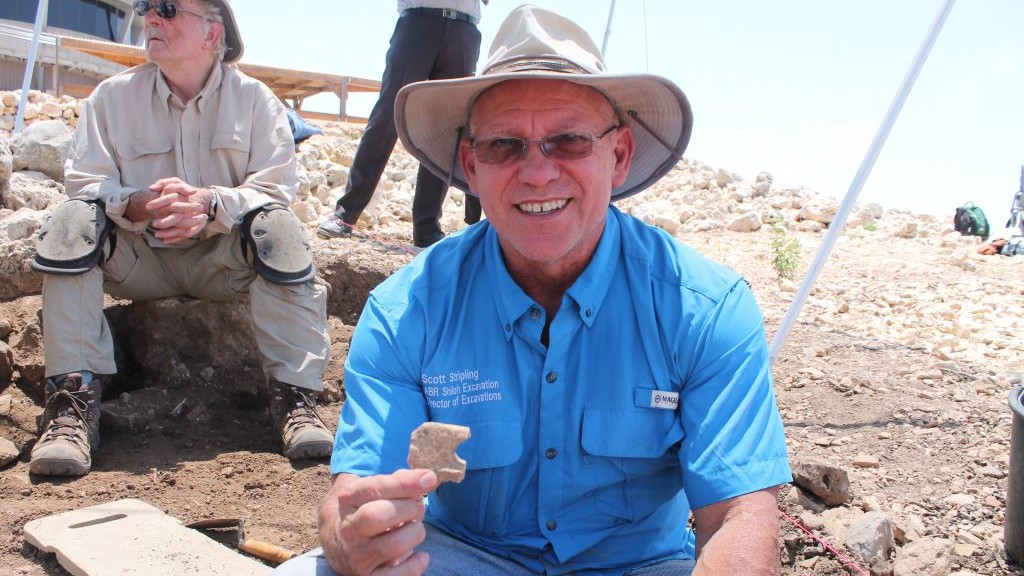CORRECTION: A previous version of this article stated that the discovery by Stripling’s team could be proof of the true time period of the biblical exodus. It has been corrected to read that the discovery could be proof of the true age of the Bible itself.
A tablet containing the words of an ancient Hebrew curse predating the Dead Sea Scrolls has been uncovered and translated by an archaeologist from Katy. The discovery, announced Thursday, could be proof that the Bible is hundreds of years older than scholars previously thought.
Dr. Scott Stripling – director of the Archaeological Studies Institute at The Bible Seminary in Katy – led the team that discovered the small, folded lead tablet on Mount Ebal in Israel. It reads, “Cursed, cursed, cursed – cursed by the God Yahweh. You will die cursed. Cursed you will surely die. Cursed by Yahweh – cursed, cursed, cursed.”

The age of the Bible has long been a subject of debate.
The Dead Sea Scrolls are considered the defining artifact that determines the book’s age. Those scrolls were written about 150 B.C.
Separately, some historians say that the Bible, including the Book of Exodus, which details the Israelites’ flight from Egypt, was written somewhere between 600 B.C. and 300 B.C., during what are known as the Persian period and Hellenistic period, respectively.
This take, known as the Deuteronomistic theory, supports an argument that the Bible could be a “revisionist history” account written some 600 years after the Exodus actually took place. It is based on the idea that the Israelites would not have had the ability to write religious texts at the time the actual Exodus occurred.
The archaeological community is divided almost in half regarding the age of the Bible, Stripling said. Scholars like him believe the Book of Exodus was a firsthand account written concurrent to the events in the Bible.

The tablet discovered by Stripling’s team was written about 1500 B.C., which would be proof that the Hebrews were writing in the same stylistic and linguistic manners in which the Bible was written.
“We now have the name ‘Yahweh’, the biblical God of Israel, in an inscription dating from (Late Bronze Era II), which is earlier than many skeptics would argue that the Bible existed or that there was even the ability to write down a sacred text,” Stripling said.
The artifact is at least 200 years older than any other Hebrew text in existence – and 1,350 years older than the Dead Sea Scrolls.
“One can no longer argue with a straight face that the biblical text was not written until the Persian period or the Hellenistic period as many higher critics have done, when here we do clearly have the ability to write the entire text at a much, much earlier date,” Stripling said.

The tablet is small, measuring only 2-centimeters-by-2-centimeters in size. It’s classified as a defixio, which is Latin for “cursed tablet.”
The tablet was folded in half, so in order to read the text without destroying it, Stripling formed a collaboration with four scientists from the Academy of Sciences of the Czech Republic and two epigraphers to read the text.
The tablet’s author would have been a highly educated male religious leader, said Dr. Gershon Galil, a professor of biblical studies from the University of Haifa. “It is clear that the person who wrote this was a genius,” Galil noted. “He was not only a scribe, he was a theologian. He was a leader.”
The curse was probably directed back at the author as a reminder to himself of God’s wrath should he fail to submit to the will of God, Stripling added.
The author most likely used an iron stylus to scratch the words into the lead, Stripling explained, which was a common method of inscription at the time. “In the oldest book in the Bible, in Job 19:24, there’s a reference to inscribing with an iron pin on lead,” he noted.
Mount Ebal was known in the biblical books Joshua and Deuteronomy as “the mountain of curse,” so it was logical that the text would have been found on the mountain, said Galil.
An academic, peer-reviewed article on the archaeological find is in process and will be published later in 2022.








